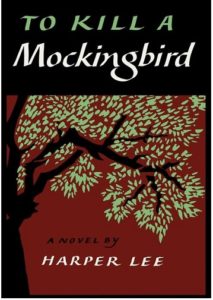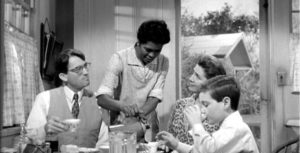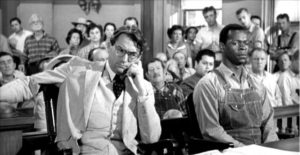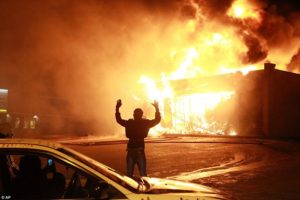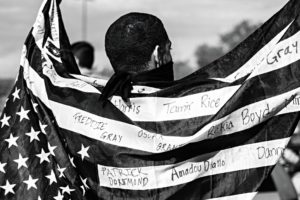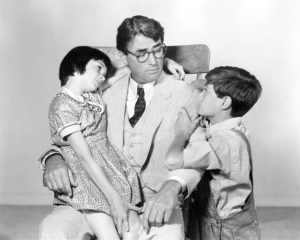In 1963 I read Harper Lee’s novel, To Kill a Mockingbird, for the first time in the American Literature class of a superb teacher, Mrs. Bernice Johnson. She taught the book through free discussion and application to whatever was familiar to us in Northern Indiana, where at that time there were only a few black students in our school. Our city was next to Gary, the place where the number of black residents had risen dramatically during the late 1950’s and early 1960’s. I knew little about race relations then until after reading Harper Lee’s wonderful book. My only contacts with black people were at bus depots and occasionally at the public library. Some of my experiences with them involved friendly discussion or just getting or giving directions to certain places. There was little idea in my mind about oppression or the treatment blacks received in their daily lives in Northwest Indiana.
Some level of change came gradually through the work of Dr. Martin Luther King, Jr., Medgar Evers, Stokley Carmichael, Shirley Chisolm, and others renowned for their compassion, intelligence, and ability to lead and bring about some level of change. That change became more visible in the mid 1960’s through peaceful marches, books, and visibility of eloquent blacks who conveyed messages of hope for those who were oppressed in a nation filled with white denial and lack of sympathy, due to an appalling lack of experience with black folks (and vice versa). There was so much presumption on both sides through comments like one from an uncle of mine who deemed black people “lazy” even though he was unable to name even one black person he had met and knew.
I remember being at the home of my maternal grandparents for a visit one afternoon after school, and on the news was a film clip of Dr. King and a huge number of other people singing “We Shall Overcome.” I thought I understood what was intended by the lyric, but my grandmother peered over her eyeglasses to ask (quite innocently), “Overcome what?” As my grandparents had grown up with blacks as servants and workers (who were treated kindly and generously), they actually didn’t begin to understand or see the oppression until Rosa Parks refused to give up her seat at the front of a bus, or the young men who demanded to be served at a lunch counter in the South, where a sign read “NO NEGROES.” Those images began to gnaw at the undercurrent of conscience in many Americans sixty years ago, and the peaceful marches at that time slowly brought visibility until riots came with flames and hatred rekindled, mostly by white Southerners, who were used to ruling the roost, especially being what my parents called “white trash,” those whose only illusion of dignity came from mistreating their black brothers and sisters as inferiors. The Civil Was had not really ended in the South.
Over the past few months, I have been watching news casts about new protests, most of which have been well-meaning, even if impractical and annoying to commuters and others whose use of a few large cities was impeded by massive crowds, some of which became destructive mobs lashing out at everything and everyone in a blind scatter shot of rage against anyone who was the wrong color. There seemed to be some level of karma in all this. Of course, it’s possible that some of those mobs were staged and supported by whites who wanted the tide of racial equality to be stopped. In any case, my original level of sympathy ebbed when I saw the wanton destruction of historical monuments, which often really need to remind us of history so that we don’t repeat it. The ugly parts of history are perhaps among the most important ones to preserve if only to goad us into doing better in the present and future. Blind indignation is bad if it doesn’t remind us that we can and must do better. The wake of such pointless ruins serves no purpose but to inflame more anger on the part of those who have been mistreated by the already abused. I wonder about what level of success is expected by violent and visionless rage that leaves in its path only destruction, ugliness, and horror.
Abuse shouldn’t occur on either side of this argument over racial equality. It serves no purpose but to ruin any progress that may already have been made or is yet to be achieved.
I just came in from my front yard, where Adjou and his Haitian work crew trimmed my lawn and the trees, which they have been doing for several years now. Their work is exceptionally good. There are also black lawyers, teachers, doctors, everywhere. That connection is a microcosm of a larger view of race. We all in this society need each other and can make things work well through mutual respect, honesty and hard work. Change is occurring, but utopia is not in sight for us as a nation…or as a world. Much remains to be done through all our efforts and hopes. If I sound like Pollyanna, so be it. I do see a glimmer of light at the end of the tunnel (Please excuse the tired cliché, but hope is the only thing we have right now). As a teacher of high school English for thirty-five years, I taught the novel To Kill a Mockingbird many times, and when I still read it now and again, it still gives me hope that change can and will continue to benefit all of us, not just the few. We need to see all sides if we can, and hold up values espoused by Atticus Finch. We need him now more than ever before. JB

